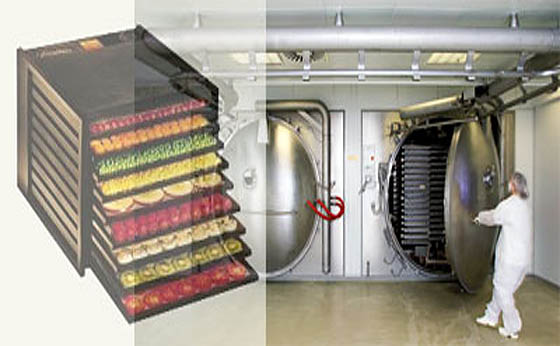Dehydrated Food versus Freeze Dried Food

Are you curious to know the basic differences between dehydrated food and freeze dried food?
Lots of preparedness-minded people who have a so called ‘deep pantry’ and will often have a variety of foods for longer term storage including dehydrated foods and freeze dried foods.
Here are the basics regarding each process:
DEHYDRATED FOOD
Dehydration is the process of removing water from a substance, in this case – food. Dehydrated foods have much of their water content removed.
Many preparedness food-storage vendors sell dehydrated foods, however it also a process that you can do right in your own home with either a low-temperature oven or a purpose-built food dehydrator, similar to this one… Excalibur.
During the process, moisture is removed from the food by slowly heating it at temperatures which may range from 115-F to 155-F depending on the recommendations for the food type itself. Typically a fan circulates the air within the food dehydrator to evenly distribute the heat. The process time may range from 8 hours to 12 hours or more, depending on the moisture content of the food and other factors.
When finished, typical ‘dehydrated food’ moisture levels are reduced to levels in a range from 10 to 20 percent – depending.
Home dehydrated foods may have a ‘typical’ shelf life ranging from six months to a year, however it is fairly easy to obtain much longer shelf life for many dehydrated foods by drying them longer, keeping them in a cool-dry storage environment, and properly packaging the food (vacuum sealer).
Dehydrating at home is a great way to store extra food from your garden, or vegetables and fruits you have purchased at the market at a great ‘sale’ price.
Advantages of Dehydrated Food
No waste
Lightweight
Low moisture
Do it yourself
Long shelf life
Not easily spoiled
Costs less than freeze dried food
FREEZE DRIED FOOD
Freeze drying is also a dehydration process – with some differences which enable the food to become MUCH DRIER than dehydrated food.
The freeze-dry process is a professional process which is very expensive to reproduce at home.
The foods are processed / frozen, and during the freezing process the surrounding air pressure is reduced in a vacuum chamber to enable the (frozen) water in the food to change from a ‘solid phase’ to a ‘gas phase’ in order to remove even more moisture.
Freeze drying removes more water from foods than dehydrating (down to just a few percent!), so it lengthens the shelf life. Many vendors of freeze dried foods claim shelf life as long as 25 years.
Freeze-dried foods can taste amazingly delicious due to the unique process which retains even more flavor and nutrients.
Advantages of Freeze-dried Food
Very long shelf life
Very lightweight
Very low moisture
Reconstitutes quickly
Best way to dry meat items
Generally tastes better than dehydrated
Retains original shape, texture, color after reconstitution
Both dehydrated and freeze-dried foods have a place in one’s diversified food storage. Freeze-dried foods are more expensive although very light weight with a long shelf life. Dehydrated foods can be processed at home, albeit with a shorter shelf life.
